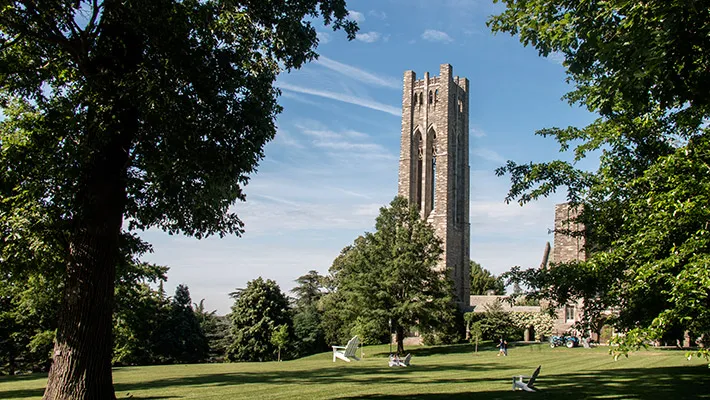Swarthmore Implements Carbon Charge for Current Budget Year

Director of Sustainability Aurora Winslade and Vice President for Finance and Administration Greg Brown shared the following community message this week:
Dear Swarthmore Community,
We are pleased to announce that, based on a proposal put forward by a group of faculty and staff, Swarthmore College has implemented a Carbon Charge in its operating budget, beginning at the start of the fiscal year on July 1, 2016. As one of the first institutions in higher education to make this commitment, this initiative affirms Swarthmore’s leadership in sustainability efforts in higher education. At the same time, it represents a meaningful step forward in achieving our shared goal of carbon neutrality by 2035.
Why a Carbon Charge?
We as a college believe that climate change poses one of the greatest threats to humanity in our lifetimes. Unfortunately, it is challenging to mitigate climate change, among other reasons, because those producing carbon emissions do not feel the associated costs directly. A Carbon Charge makes the real costs of carbon emissions visible, thereby motivating their reduction. In fact, many economists believe that a national or international price on carbon emissions would reduce carbon emissions on a global scale.
For Swarthmore, we hope the Carbon Charge will foster a sense of collective responsibility and agency for minimizing our carbon impact, generate revenue that can be reinvested in campus initiatives to advance energy efficiency and renewable energy, and allow us to more rapidly reduce carbon emissions within our own community. This step also allows us to join a leading group of institutions who are modeling strategies that could be scaled up to have meaningful national and global impact.
Implementation
In the new fiscal year, you will see a line item for the Carbon Charge appear on your department’s budget. This year, every department will be charged 1.25% of its total operating budget, excluding salaries and benefits. For this first year, to ensure that every department has the chance to develop a plan for the future based on concrete data, departments will receive an additional allocation to cover the expense. If your department feels able to contribute that additional allocation to sustainability efforts this year, please contact us at sustainability@swarthmore.edu. A new Carbon Charge Committee will make recommendations on how to further develop the Carbon Charge in future years.
In addition to the charge to departments, we will also be exploring implementation of a shadow pricing policy on capital projects, whereby evaluations of the expenses of different options for construction projects will include the costs associated with the lifecycle carbon emissions each option will entail. This addition would facilitate selection of lower-carbon options in heating source, energy source, construction materials, and other components.
Benefits and Uses of Carbon Charge Revenue
The revenue from the Carbon Charge will directly support sustainability projects here on campus, including renewable energy installations, energy efficiency upgrades, improved metering, and other projects that will help reduce Swarthmore’s climate impacts, including community education and incentives to reduce energy use. A process for collecting community input and approving proposals is in development.
Learn More about the Carbon Charge
You can learn more about the Carbon Charge by visiting our website or by attending a brown bag lunch where we will explain the Carbon Charge in more depth. The first lunch will be in Bond Hall at 12:15 on Monday, September 12. Nathan Graf ’16 was recently hired as the Climate Action Senior Fellow to implement the Carbon Charge; please contact Nathan with any questions at sustainability@swarthmore.edu.
Learn More about Mitigating Climate Change
We’re designing new opportunities for ongoing learning, discussions, and community engagement. Please fill out this short Google form to help us assess levels of interest to inform future programing. We ask that all faculty and staff fill out the form so we can get an accurate sense of the community.
Help Reduce Carbon Emissions at Swarthmore
We’re among the first few institutions of higher education that have implemented a carbon charge, so we will be learning as we go. Of course, different departments will have different needs and different opportunities for reducing emissions. We encourage you to reach out to sustainability@swarthmore.edu to discuss how to tailor carbon reduction strategies to your department.
Reduce Emissions Now
Community-wide education about emissions reduction strategies will be part of the implementation of the carbon charge in the near future. For now, here are a few initial steps to reduce your carbon emissions:
- Temperature: Keep the temperature a few degrees closer to the outside temperature. Turn off thermostats at night and on weekends. If you don’t control a thermostat for your office, contact us at sustainability@swarthmore.edu and we’ll work with you to modify the temperature.
- Lights: Turn off lights at nights and on weekends.
- Appliances: Turn off coffee makers, computers, monitors and other appliances at night, on weekends, and when they're not in use.
Finally, here’s the link to the Google form one more time. Please take two minutes to fill it out. We look forward to working together as a community to ensure a more sustainable future.



